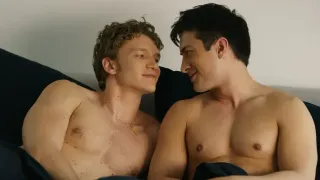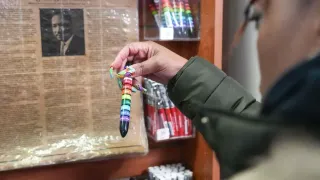May 25, 2017
Choreographer Sam Pinkleton: Making 'The Great Comet' Dance Without a Stage
Robert Nesti READ TIME: 13 MIN.
Towards the end of the first act of "Natasha, Pierre & the Great Comet of 1812," there is a fancy ball -- the first that Natasha, a newcomer to life in Moscow, attends. As it unfolds in various parts of the Imperial Theatre, where this extraordinary musical has happily found its Broadway home, dancers pair up, some in ways that would likely have been forbidden in Imperial Russia.
This same-sex partnering is one of the many anachronisms found in Dave Malloy's adaptation of a slice of Tolstoy's "War and Peace," which began in Manhattan's Hell's Kitchen in 2012 in a theater that sat 87. It was an immediate sensation thanks to Malloy's eclectic barrage of musical styles that comprise its through-sung score and Rachel Chavkin's staging, which dispensed with a conventional stage and fragmented the action on runways that ran through the theater.
The following year it was restaged, this time in a temporary tent (called Kazino) that sat 200 in the Meatpacking district whose interior was made to look like an authentic Russian club (called Cafe Margarita) that Malloy and Chavkin had seen on visit to Moscow. In this iteration, a meal was served beforehand and vodka was poured throughout the performance. Again, it was a sensation; and became a runaway success moving uptown to the theater district in a tent that sat in a lot next to the Imperial Theatre (with a little less vodka).
But "The Great Comet" still had room to grow, this time in the proscenium-styled space at Cambridge's American Repertory Theater, where it opened in December 2015. The 600-seat house was transformed into a Russian club with hundreds of paintings adorning crimson walls and the stage transformed into nightclub with tables and banquettes where some of the audience were seated. Platforms and runways ran through the entire theater on which the action took place, which only underscored the immersive nature of the staging. One minute an audience member is being offered a pirogi, the next an actor can sit in their lap. During the ballroom sequence, same sex performers dance inches from some in the audience.
That fancy ball is only part of the remarkable work of choreographer Sam Pinkleton, who joined the creative team during its second engagement (the one in Kazino). Working closely with Chavkin, Pinkerton designed the movement as the show grew to its current size -- now a full Broadway musical with a cast of some 43, a larger band, 400 paintings on its walls, 31 chandeliers and Josh Groban, whose star-power ensured that the $12 million dollar production would draw a sizable audience.
Like his peers on the creative team, Pinkleton comes from the downtown theater scene, having worked on such productions as "Machinal" at the Roundabout on Broadway; off Broadway he his credits include "Kansas City Choir Boy" (with Courtney Love); "Rimbaud in NY" at BAM; "Pretty Filthy" with The Civilians; "Mr. Burns, A Post-Electric Play," "Stage Kiss" and "Fly By Night" at Playwrights Horizons; "Marie Antoinette" at Soho Rep; and "The Lightning Thief" at Theatreworks USA. Interestingly, he doesn't come from a traditional dance background, but is fast becoming one of the most sought-after choreographers on Broadway. Just this season alone, he's worked on three shows: in addition to "The Great Comet," he worked on "Significant Other" and "Am�lie." For his work on "The Great Comet," he was nominated for a Tony Award for choreographer. It was one of the show's 12 nominations, which made it the most honored of the season.
EDGE spoke to Pinkleton on the day before the Tony nominations were announced
Choreographing without a stage
EDGE: Were you involved in the first production at Ars Nova?
Sam Pinkleton: No. I actually just saw it at Ars Nova. I am an old friend of Dave and Rachel and bought a ticket. I just fell in love with it. When they filled it out in the tent, which was like four versions ago, I joined then. I have been working on it for just over three years.
EDGE: Even in the tent, was the physical layout the same with runways running through the audience and no center stage?
Sam Pinkleton: Yes. The tent was just runways. There was one little surface that was five feet deep. And there were 16 cast members and 200 audience members. On Broadway, we have 30 onstage as well as six or seven off-stage, and something like 1100 or 1200 people in the audience.
EDGE: What is like choreographing a musical without a stage?
Sam Pinkleton: It's a dream, actually. I love obstacles and I love tough assignments. It was this puzzle that required an amazing combination of ingenuity and practicality to solve, like this huge math problem. I would never want to do this on a regular stage. My favorite part is figuring out as a choreographer where things happen, for instance, 'we danced here on this platform, what can we do on the stairs? Or that platform out in the audience?' It is the greatest challenge I have taken on and the most fun I have ever had.
And it is very important to me that the each member of the ensemble each feel like an individual, not like part of one big, Broadway chorus where everybody looks the same and moves the same. My question is, 'What can they do that's different than anybody else?' Everybody is a little different depending on where in the room they are and who they are, if that makes sense.
A real collaboration
EDGE: Was it difficult to create movement for a through-sung score that's always changing its musical identity? It is classical one minute, techno the next...
Sam Pinkleton: Yes. Dave's score, as you heard, is so deeply anachronistic. One minute you are in Russian folk music, the next you're in techno. So the movement has to change that way too. The fun part of it is to do it with confidence and not apologizing for it, and to make it happen on a dime. It's just a case of embracing the extremes rather than easing in, if that makes any sense.
EDGE: That anachronism you mentioned gives the show great energy. Did it liberate you as the choreographer?
Sam Pinkleton: Absolutely. It is sort-of that old-fashioned thing that if the music is good, the dancing will be good. And if the music is going to make choices that are bold, I have to make choices that are bold. It is a requirement. And it is incredibly liberating. I never worked on the show where you actually can take on so many different styles. You actually are required to invent styles, which Dave and Rachel have done, and also be able to celebrate individual bodies in ways that makes them weird and special.
EDGE: Having seen the show in at the American Repertory Theater in Cambridge, it feels so much bigger on Broadway. But in both places, one of the show's greatest strengths is the way the company members interact with the audience. How did you find that comfort level for the actors to do that?
Sam Pinkleton: It was a real collaboration. That has always been in the DNA of the show. One of the joys of working on something for so long, the whole team develops a shorthand. It is a real delicate balance. It is something that Rachel and I have developed over time. For me the most important part is that we include the audience in the event. So the gauge I tell the actors to use is to present an authentic version of yourself. To look at people and say, 'hey I am looking at you and making eye contact.' That can be very meaningful. And it is different then, 'we're going to participate and do it on stage!'
Same-sex coupling
EDGE: In the ballroom scene, there is quite a bit of same sex dancing, which you would have never found in Imperial Russia. How did this anachronism find its way into the show?
Sam Pinkleton: We have this huge ball and we wanted to fill the room out as much as possible. Our whole team is incredibly unconvinced by heteronormative performance style found on Broadway. I don't understand that if we are doing a musical about Imperial Russia with techno music and an incredibly diverse cast why that diversity would not be reflected in every possible corner. For me it is not even a statement, it's just the world as it is. I think if part of the mission is to make every actor feel like their presenting an authentic version of themselves and make every audience member feel that they're truly being included, part of it is making the show look like the world.
It is so fun for me because I don't have a traditional dance background and I certainly have never staged a fancy ball. And to release myself as a choreographer from "this is a boy part. This is a girl part. The boy leads this way..." I don't know who made those rules, but they were made a long time before I was born and we are ignoring them. Instead, for the ball dancing, there's an A and there's a B and everyone learns both parts. The way we rehearsed it was almost like social dancing. I would say, raise your hand if you're 'A,' then raise your hand if you're a 'B,' now switch. And it became genderless. I don't know if you know this, but the understudies cover both men and women. So one night you may be dancing with a guy, the next you are dancing with a girl. I love when people notice it and also I like to believe that we are not just patting ourselves on the back. It is the same thing like Den�e Benton, who plays Natasha, is African-American; in 1812 Russia, she probably wasn't African-American, but Den�e is that character. It is what it is. It is the most essential version of the story we are telling, and I feel the same about the same sex couple. It is what it is.
EDGE: The show has gone through so many iterations, getting bigger and bigger each time. Was there a moment when you realized you had something so special?
Sam Pinkleton: I always think it is dangerous to think that something is special. I feel like that is other people's job to say. Also the moment you think something is special is the second you start making it precious. We have all been guided by an incredible faith and trust in the vision of Dave and Rachel, who ultimately conceived this. It is always fun and for something this deeply complicated to always be fun says to me this is worthwhile. With this show there were challenges I had never taken on before and it is being answered with boldness and with humor, and so it always just felt like something to stay close to.
The Russian dance
EDGE: As for yourself, you don't come from a dance background?
Sam Pinkleton: Not at all. My college dance teachers told me that I would be successful as long as I avoided dance. I kind-of wanted to be a chorus boy, but I didn't have the skills because I wasn't a good enough dancer. And I kind-of trained to be a director. The thing I love about dance is the thing that happens when people who hadn't had dance training hear music and their bodies do something. It is the animal thing; it is the ancient thing; it is the folk thing. People move to music because music is awesome. That's so much more interesting to me than some woman screaming at me what my feet do or do not do. I think of dance, regardless of what the so-called style, is as an opportunity to truly express yourself, and to express yourself in a way that words can't. To be completely be yourself and to be completely be yourself in your body. A lot of people would argue with me on this, but that has always been my way in and that is partially because it is all I know how to do. I don't have real training, but I was always the person who loved jumping around and turned on loud music and made stuff, and it was stuff that felt good to me and to other people. That's also what folk dancing is, right?
EDGE: In the second act, there is this incredible Russian dance that comes out of nowhere and builds to be this incredible show stopper that fills every corner of the theater. How did it come about?
Sam Pinkleton: That was sort of this wild beast. That number started as a very simple song between three people. In the tent there was almost no choreography. Then in Boston we thought, this may be a dance number. Then we thought, this may be our big second act dance number. There was a very clear moment when we were in Cambridge when Dave Malloy nervously came up to me and whispered in my ear, 'do you think there should be a dance break?' Suddenly this show from Ars Nova suddenly became a Broadway musical. So by the time I came to New York and I got the incredible gift to work with some real dancers - and some of my favorite dancers in the world are in this show. It was like, 'here are the keys! Go.' We are doing 'The Great Comet' in the theater where 'Dreamgirls' and 'Fiddler' premiered, so the question of how do you keep the show true to what it is, but also true to the size and scale of the Broadway show? And the answer is big ass dance numbers. It's been amazing. It's been the most fun I have ever had.
A gay musical theater kid
EDGE: Would you like to choreograph a classic musical?
Sam Pinkleton: I would love to. I love 'The Music Man' more than anything else in the world. To my last point as to what I think dance is, dance is a joy machine. And some of the great musicals are that -- the energy from some of these musicals is nothing but pure, human joy. I don't think I can do it in a traditional sense, but I would love to take one of those big, traditional scores and find my way in to it. I love working at that scale. And I love musicals. I was a kid into cast albums. I was a gay musical theater kid, proudly.
EDGE: Do you see yourself more a director or a choreographer?
Sam Pinkleton: I always think that I would be more of a director, but that was partly because until recently didn't think I had the skills to be a choreographer. Then I asked, 'who makes those rules? Who said there was a skill set?' And I decided to do it. I love doing both. I love working with directors as a choreographer if it is a director that I adore, like Rachel Chavkin'; similarly as a director I like working with choreographers. Last summer i directed 'Runaways' at city center and Ani Taj, who is a dancer from 'The Great Comet' and it was an amazing collaboration. I want to do 'Bye Bye Birdie' with 70 people and being the director/choreographer. That would be thrilling.
EDGE: In a show with so much movement throughout the theater, how do you keep mishaps from occurring?
Sam Pinkleton: Well, because we've been doing it a long time, we have figured out ways of keeping disasters from happening. But when we were in the tent, there were many mishaps, largely related to the amount of vodka we allowed the audience to drink. There was a night when a lady vomited, there were a many nights when someone vomited. The tent was like something in between doing a musical and running a disco in 1981. It was pretty wild.
"Natasha, Pierre & the Great Comet of 1812" is currently playing a the Imperial Theatre, 249 West 45th Street, New York, New York. For more information, .
Watch the trailer for "The Great Comet":
Watch these clips from "The Great Comet":
Watch this clip of Josh Grobin and "The Great Comet" cast performing on the Today Show:






